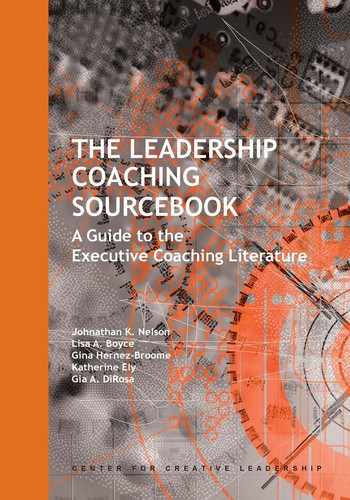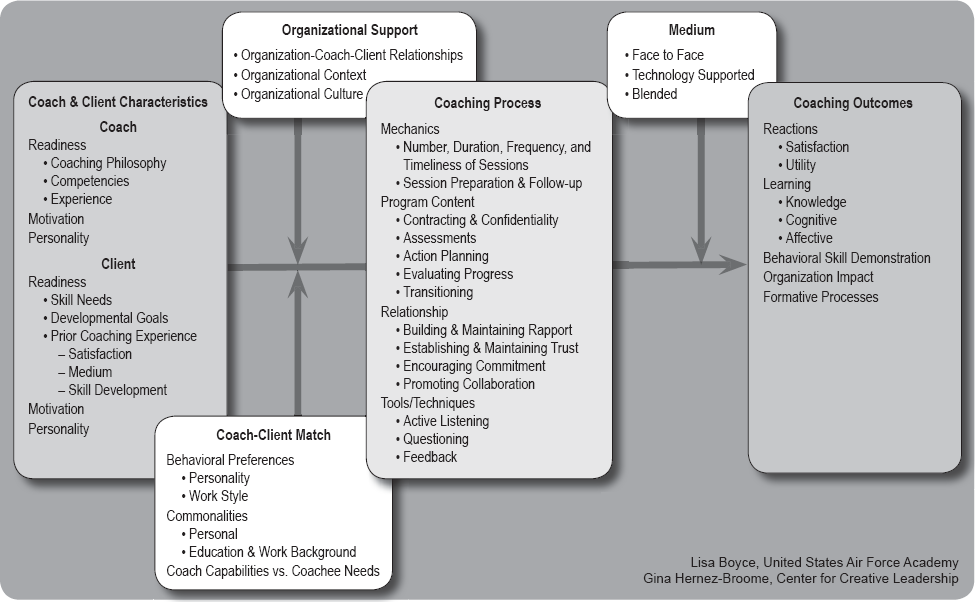Section 3. Introduction of the Leadership Coaching Framework
Coaching is a complex social system in which many factors interact to impact the success of a coaching program. Systems theory (Katz & Kahn, 1978) provides us with a tool to examine such a complex system by allowing us to frame the key variables that work together to produce effective results. The three central components of an I-P-O model are the input or the external factors that enter the system, the process or the actions taken upon the input materials, and the output or the results of the process. The Leadership Coaching Framework (Boyce & Hernez-Broome, 2007; see Figure 1, p. 14) uses an I-P-O framework to frame the key issues relevant to executive coaching, including coach and client characteristics (input), the coaching process, and coaching outcomes (output). Additional components that may moderate or impact the relationships between the input and process include the coachclient match, organizational support, and the medium through which coaching occurs.
Although this framework is presented in Advancing Executive Coaching: Setting the Course for Successful Leadership Development (Hernez-Broome & Boyce, 2010), we provide a brief review of this model here as an organizing strategy for the sourcebook. The six components illustrated in Figure 1 were employed to select, examine, understand, and summarize the published literature. In addition, the framework provides a mechanism for future research to systematically consider, investigate, and promote evidenced-based coaching, as well as a tool for practitioners to systematically examine and develop coaching practices.
Coach and Client Characteristics
The coach and client enter a coaching engagement with preexisting characteristics, such as a level of readiness, motivation, and personality. Level of readiness implies that coaches have varying degrees of experience and range and depth of competencies, and differing perspectives or philosophies about coaching itself. Similarly, clients bring different levels of experience, skills, and needs to the coaching process. Coach and client motivation as well as their unique personality differences are also particularly relevant, as they influence not only their behaviors toward particular goals but also their emotional and cognitive processing, such as with feedback.
In addition to understanding the coach and client, the match or fit between coach and client is critical to the partnership and the success of the coaching engagement. Possible factors to consider when aligning coaches with clients include compatibility in personality preferences, commonalities in professional and personal values, interests and experiences, and coach credibility referent to the client’s needs. Personality preferences refer to the compatibility between coach and client personality and work/learning styles, which may impact coaching processes ranging from establishing initial rapport to later stretch activities. Commonalities capture the underlying features that attract individuals to each other and support communication and relationship development and maintenance, such as demographic variables (for example, gender, race, and age), work and education backgrounds, and personal interests and activities. Credibility encompasses the extent to which the coach possesses the specific capabilities and experiences to support the client’s perceived and real needs.
Leadership coaching does not occur in a vacuum; organizational influences need to also be considered in coaching research and practice. The relationships between key organization stakeholders, coach, and client, as well as the organizational context and culture, may affect the coaching process, such as program mechanics, contracting and confidentiality, and the effectiveness of the assessment tools and action strategies. These organizational factors are expected to impact the effects of individual coach and client characteristics on the coaching processes, such as integrating client goals and action plans into the work environment, fostering learning transfer, and sustaining the developmental process.
The coaching process is partitioned into four major subprocesses: mechanics, program content, relationship, and tools and techniques. Mechanics focus on the logistics of the coaching session (for example, number, duration, frequency, timeliness or responsiveness of sessions, and session prep and closure, including preparing an agenda, completing homework, and documenting the meeting). Although individual coaches may identify with certain models of coaching, most coaching programs include similar content or elements, which include contracting, establishing confidentiality, assessments, action planning, evaluating progress, and transitioning. The four key processes associated with the client-coach relationship are building and maintaining rapport, establishing and maintaining trust, encouraging commitment, and promoting collaboration. These four social constructs involve a mutual responsibility between a coach and client. Finally, tools and techniques include the actual coaching behaviors (for example, active listening, questioning, and feedback).
With the majority of coaches coaching in mediums other than face-to-face using tools ranging from e-mail to virtual simulations, the impact of the coaching medium is of growing interest. Adding technology to the already unique nature of a one-on-one coaching process increases the complexity of the interaction. Therefore, the medium by which coaching is delivered (face-to face coaching, technology supported, or blended delivery) is framed as moderating the relationship between the coaching process and coaching outcomes.
Assessing coaching outcomes is critical to practitioners and researchers in determining the effectiveness of coaching programs and processes. The framework considers leadership coaching outcomes from a training perspective but also acknowledges the unique aspects of coaching as a learning and development intervention. Therefore, relevant coaching outcomes include the traditional summative training criteria, such as reactions, learning and behavioral skill demonstration, and organizational impact (Kirkpatrick, 1994), as well as formative or process criteria. The broad factors encourage the tailoring of criteria to meet coaching’s specific and evolving purposes, such as incorporating cognitive and affective outcomes (for example, cognitive flexibility and self-efficacy). We encourage you to review Ely et al. (2010) for a more complete discussion of coaching evaluation within the Leadership Coaching Framework, as the distinctive aspects of coaching present additional challenges for assessing outcomes for both practice and research.
The Leadership Coaching Framework consists of six components that support the examination of key coaching factors. Further, the framework assembles key factors within the components to emphasize their relationships and interconnections. The framework, therefore, provides a useful structure to examine the coaching literature to increase our understanding of the state of the field, generate methodical research, and better inform and guide practice.

